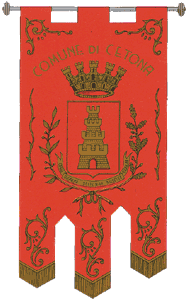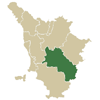|  Inhabitants in 1991: 3.028
Inhabitants in 1991: 3.028
 The
municipal territory of Cetona extends for 53,19 square kilometres in the
Val di Chiana, on the eastern slopes of Monte Cetona. The community
had its origins as a feudal centre. The
municipal territory of Cetona extends for 53,19 square kilometres in the
Val di Chiana, on the eastern slopes of Monte Cetona. The community
had its origins as a feudal centre.
In a territory inhabited in Etruscan and Roman times, the castle of Cetona
was recorded for the first time at the beginning of the XIII century
as feudal to the Ildebrandino Counts, even though it was already under
the political jurisdiction of the municipality of Orvieto. Object of bitter
and long contest between Siena and Orvieto, around 1260 Cetona
was sold to the latter by the heirs of Count Ildebrandino and annexed
to the Orvieto district. In the middle of the 1300s Orvieto saw its dominion
over the territorial castles crumble under the hand of various patrician
families who had gravitated into the orbit of the Perugia municipality
and thus in the church’s State; a nephew of Pontiff Gregorio XI
was invested over the dominion of Cetona (1367) and in 1375 transferred
the possession to the Counts Monaldeschi di Cervara.
In 1418 Cetona was conquered by Braccio di Montone and sold to
the republic of Siena, who after the occupation of the castle by Iacopo
Piccinino (1455) re-enforced the fortifications in 1458; and Cretona remained
loyal to Siena until the Medicea conquest (1556). From 1558-1596 it was
conceded by Cosimo I in feudal as Marquisate to the Vitelli family and
it was successively reintegrated into the Grand Duchy.
Places to visit:
Civic Museum for the Prehistory of Monte Cetona, organised
with finds from the Palaeolithic to the Bronze age, coming from the
excavations in the area.
Collegiate, erected in 1200s is abutted to the external perimeter
of the walls of the fortress. The interior preserves 1400s frescoes. |
Historical info reproduced upon authorization of Regione Toscana - Dipartimento della Presidenza E Affari Legislativi e Giuridici
Translated by Ann Mountford |